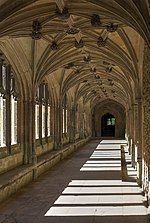Lacock

Lacock is a village and civil parish in the county of Wiltshire, England, about 3 miles (5 km) south of the town of Chippenham, and about 3.7 miles (6.0 km) outside the Cotswolds area. The village is owned almost in its entirety by the National Trust and attracts many visitors by virtue of its unspoiled appearance. The parish includes Bowden Hill, a small village 1 mile (1.6 km) to the east of Lacock, and the hamlets of Bewley Common, Notton and Reybridge. The Chippenham–Melksham section of the A350 primary route crosses the parish from north to south, as does the River Avon. A scarecrow festival is held annually in Lacock and is popular with visitors from the local area. All funds raised are donated to Lacock Primary School.
Excerpt from the Wikipedia article Lacock (License: CC BY-SA 3.0, Authors, Images).Lacock
West Street,
Geographical coordinates (GPS) Address Nearby Places Show on map
Geographical coordinates (GPS)
| Latitude | Longitude |
|---|---|
| N 51.415 ° | E -2.123 ° |
Address
West Street 15
SN15 2LQ , Lacock
England, United Kingdom
Open on Google Maps








